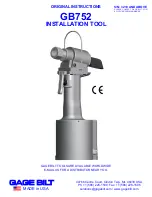
Rally Pilot Operating Handbook
Copyright 2008, Rally Aircraft
Revision 4.1
53
7.22 LANDING
The traffic pattern can be made with power-on or power-off at speed of 60 – 65
knots with flaps up, in “Base” and “Final” legs, reduce speed to 60 – 55 knots with
flaps down. Surface winds and air turbulence are usually the primary factors in de-
termining the most comfortable approach speed. Actual touchdown should be
made with power-off and on the main wheels first. The nose wheel should be low-
ered smoothly to the runway as speed is diminished controlling direction with rud-
der.
Short field landing
For a short-field landing in very smooth air conditions, make a short final approach
at 52 knots with full flaps , using enough power to control the glide path and the
speed. After all approach obstacles are cleared, progressively reduce power and
maintain 46 knots by lowering the nose of the airplane. Touchdown should be made
with power-off and on the main wheels first. Immediately after touchdown, apply
heavy braking as required. For maximum brake effectiveness, retract the flaps, hold
full nose-up elevator, and apply maximum brake pressure without sliding the tires.
Slightly higher approach speed of 62 knots should be used under turbulent air condi-
tions.
Crosswind landing
When landing in a strong crosswind, use the minimum flap setting required for the
field length and at an airspeed of 65 knots. Use a low wing into the wind, crab angle,
or a combination method of drift correction and land in a nearly level attitude.
Balked landing
In a balked landing (go-around) climb, the wing flaps setting should be reduced to
position 1 = + 10° immediately after full power is applied. Upon reaching a safe alti-
tude and airspeed, the flaps should be retracted to the full up position.
7.23 COLD WEATHER OPERATION
Prior to starting on cold mornings, it is advisable to pull the propeller through sev-
eral times by hand to break loose or limber the oil, thus conserving battery energy.
WARNING
When pulling the propeller through by hand, treat it as if the ignition switch is
turned on.
A loose or broken ground wire on either magneto could cause the engine to fire.
In extremely cold weather, the use of an external pre-heater is recommended to
reduce wear and abuse to the engine and its electrical system.
















































